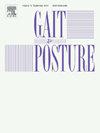步行速度自我知觉和知觉差距与虚弱的关系:奥塔沙研究
IF 2.2
3区 医学
Q3 NEUROSCIENCES
引用次数: 0
摘要
目的探讨老年人对年龄相关性步行速度下降的自我感知、感知差距(客观与主观步行速度评估的差异)与虚弱的关系。方法纳入467例老年人(年龄:74.7 ± 6.3岁;女性:62 %),她们参加了2019年(T1)和2020年(T2)在≥ 65岁的社区居住成年人中进行的综合健康检查调查。作为主观步行速度评估,参与者评价了他们在T2时与之前相比对步行速度变化的感知(消极/积极)。作为客观评价,以T2时步行速度较T1是否下降>; 0.1 m/s为标准,将其分为步行速度下降或保持稳定。据此,参与者被分为阴性+衰退(ND)、阴性+稳定(NS)、阳性+衰退(PD)和阳性+稳定(PS)组。NS组和PD组存在感知差距。在T2时使用Kihon检查表评估虚弱程度。协变量包括性别、年龄、健康状况和精神状态。采用协方差分析和二元逻辑回归分析检验自我知觉、知觉差距和脆弱之间的关系。结果消极自我知觉和感知差距的患病率分别为66.6% %和58.7% %。消极自我知觉组的虚弱得分和患病率高于积极自我知觉组;知觉间隙组与无知觉间隙组之间无显著差异。四组比较,ND组和NS组KCL评分高于PD组和PS组。结论负性自我知觉与虚弱相关,与知觉差距无关。解决负面看法可能有助于防止脆弱。知觉相关因素有待进一步研究。本文章由计算机程序翻译,如有差异,请以英文原文为准。
Association of self-perception and perception gap in walking speed with frailty: The Otassha study
Objective
To examine associations among the self-perception of age-related walking-speed decline, perception gap (discrepancy between objective and subjective walking-speed assessments), and frailty in older adults.
Methods
We included 467 older adults (age: 74.7 ± 6.3 years; female: 62 %) who participated in the 2019 (T1) and 2020 (T2) comprehensive health-checkup surveys conducted among community-dwelling adults aged ≥ 65 years. As a subjective walking-speed assessment, participants rated their perception of walking-speed change at T2 compared to before (negative/positive). As an objective assessment, they were classified as having a decline in or maintaining a stable walking speed based on whether their walking speed at T2 declined by > 0.1 m/s compared to T1. Accordingly, participants were grouped into negative+decline (ND), negative+stable (NS), positive+decline (PD), and positive+stable (PS) groups. NS and PD groups had a perception gap. Frailty was assessed using the Kihon Checklist at T2. Covariates included sex, age, health conditions, and mental status. Associations between self-perception, perception gap, and frailty were examined using analysis of covariance and binary logistic regression analysis.
Results
Prevalences of negative self-perception and a perception gap were 66.6 % and 58.7 %, respectively. Negative self-perception groups had higher frailty scores and prevalence than those in the positive groups; no significant difference was observed between perception-gap and no-gap groups. In the four-group comparison, ND and NS groups had higher KCL scores than PD and PS groups.
Conclusions
Negative self-perception was associated with frailty, regardless of a perception gap. Addressing negative perceptions may help prevent frailty. Further research is needed on perception-related factors.
求助全文
通过发布文献求助,成功后即可免费获取论文全文。
去求助
来源期刊

Gait & posture
医学-神经科学
CiteScore
4.70
自引率
12.50%
发文量
616
审稿时长
6 months
期刊介绍:
Gait & Posture is a vehicle for the publication of up-to-date basic and clinical research on all aspects of locomotion and balance.
The topics covered include: Techniques for the measurement of gait and posture, and the standardization of results presentation; Studies of normal and pathological gait; Treatment of gait and postural abnormalities; Biomechanical and theoretical approaches to gait and posture; Mathematical models of joint and muscle mechanics; Neurological and musculoskeletal function in gait and posture; The evolution of upright posture and bipedal locomotion; Adaptations of carrying loads, walking on uneven surfaces, climbing stairs etc; spinal biomechanics only if they are directly related to gait and/or posture and are of general interest to our readers; The effect of aging and development on gait and posture; Psychological and cultural aspects of gait; Patient education.
 求助内容:
求助内容: 应助结果提醒方式:
应助结果提醒方式:


